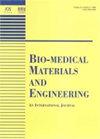骨组织工程用多孔结构材料的制备及力学性能分析。
IF 1
4区 医学
Q4 ENGINEERING, BIOMEDICAL
引用次数: 1
摘要
背景随着人口老龄化的加剧,骨折、骨质疏松等疾病的发病率不断上升。骨科对植入物的需求日益增加。现有固体金属种植体的弹性模量远高于人体骨组织,术后容易产生应力屏蔽效应,导致假体松动、融合效率低等并发症。目的为解决固体金属骨科植入物与人体骨组织弹性模量不匹配的问题,制备具有优异力学性能的金属结构。方法采用空间点阵法设计多孔结构,采用选择性激光熔融3D打印技术制备金属多孔结构。通过真空退火热处理消除制备过程中的残余应力,并进行静态压缩实验,研究不同孔隙形状和孔隙参数对多孔结构抗压屈服强度和弹性模量的影响。比较热处理前后多孔结构的性能变化,选择符合人体骨组织性能要求的多孔结构。结果采用选择性激光熔化技术制备的多孔结构符合人体骨组织的要求。弹性模量低至0.74 GPa,抗压屈服强度为201.91 MPa;退火热处理后,多孔结构的抗压屈服强度下降,最大变化3.69%,弹性模量增加,最大变化8.69%。结论对于相同孔型的多孔结构,孔隙率越低,多孔结构的力学性能越好。相同孔隙度下,十二面体多孔结构的综合力学性能最好,八面体多孔结构最差;退火热处理后的多孔结构更有利于满足人体骨组织的性能要求。本文章由计算机程序翻译,如有差异,请以英文原文为准。
Preparation and mechanical properties analysis of porous structure for bone tissue engineering.
BACKGROUND
With the increasing aging of population, the incidence rate of diseases such as fracture and osteoporosis has been increasing. The demand for implant in Department of orthopedics has increased. The elastic modulus of the existing solid metal implant is much higher than that of human bone tissue, and it is easy to produce stress shielding effect after operation, which causes complications such as loosening of prosthesis and low fusion efficiency.
OBJECTIVE
In order to solve the mismatch of elastic modulus between solid metal orthopedic implants and human bone tissue, metal structures with excellent mechanical properties were prepared.
METHODS
The porous structure was designed by spatial dot matrix method, and the metal porous structure was prepared based on selective laser melting 3D printing technology. The residual stress in the preparation process was eliminated by vacuum annealing heat treatment, and the static compression experiment was carried out to study the effects of different pore shape and porosity parameters on the compressive yield strength and elastic modulus of porous structure. The performance changes of porous structure before and after heat treatment were compared, and the porous structure meeting the performance requirements of human bone tissue was selected.
RESULTS
The porous structure prepared by selective laser melting technology met the requirements of human bone tissue. The elastic modulus was as low as 0.74 GPa and the compressive yield strength is 201.91 MPa; After annealing heat treatment, the compressive yield strength of porous structure decreased, the maximum change was 3.69%, the elastic modulus increased, and the maximum change was 8.69%.
CONCLUSIONS
For the porous structure with the same pore shape, the lower the porosity, the better the mechanical properties of the porous structure. For the same porosity, the comprehensive mechanical properties of dodecahedral porous structure were the best and octahedral porous structure was the worst; The porous structure after annealing heat treatment was more conducive to meet the performance requirements of human bone tissue.
求助全文
通过发布文献求助,成功后即可免费获取论文全文。
去求助
来源期刊

Bio-medical materials and engineering
工程技术-材料科学:生物材料
CiteScore
1.80
自引率
0.00%
发文量
73
审稿时长
6 months
期刊介绍:
The aim of Bio-Medical Materials and Engineering is to promote the welfare of humans and to help them keep healthy. This international journal is an interdisciplinary journal that publishes original research papers, review articles and brief notes on materials and engineering for biological and medical systems. Articles in this peer-reviewed journal cover a wide range of topics, including, but not limited to: Engineering as applied to improving diagnosis, therapy, and prevention of disease and injury, and better substitutes for damaged or disabled human organs; Studies of biomaterial interactions with the human body, bio-compatibility, interfacial and interaction problems; Biomechanical behavior under biological and/or medical conditions; Mechanical and biological properties of membrane biomaterials; Cellular and tissue engineering, physiological, biophysical, biochemical bioengineering aspects; Implant failure fields and degradation of implants. Biomimetics engineering and materials including system analysis as supporter for aged people and as rehabilitation; Bioengineering and materials technology as applied to the decontamination against environmental problems; Biosensors, bioreactors, bioprocess instrumentation and control system; Application to food engineering; Standardization problems on biomaterials and related products; Assessment of reliability and safety of biomedical materials and man-machine systems; and Product liability of biomaterials and related products.
 求助内容:
求助内容: 应助结果提醒方式:
应助结果提醒方式:


